HP 5120-24G-PoE+ EI Технічний паспорт - Сторінка 4
Переглянути онлайн або завантажити pdf Технічний паспорт для Перемикач HP 5120-24G-PoE+ EI. HP 5120-24G-PoE+ EI 17 сторінок. Hp 5120 ei switch series
Також для HP 5120-24G-PoE+ EI: Посібник з конфігурації (39 сторінок)

Data sheet | HP 5120 EI Switch Series
4
• Smart link
allows 50 ms failover between links
• Spanning Tree/MSTP, RSTP
provides redundant links while preventing network loops
• Rapid Ring Protection Protocol (RRPP)
connects multiple switches in a high-performance ring using standard Ethernet technology;
traffic can be rerouted around the ring in less than 50 ms, reducing the impact on traffic and
applications
• Intelligent Resilient Framework (IRF)
creates virtual resilient switching fabrics, where two or more switches perform as a
single L2 switch and L3 router; switches do not have to be co-located and can be part of
a disaster-recovery system; servers or switches can be attached using standard LACP for
automatic load balancing and high availability; can eliminate the need for complex protocols
like Spanning Tree Protocol, Equal-Cost Multipath (ECMP), or VRRP, thereby simplifying
network operation
Layer 2 switching
• 16K MAC address table
provides access to many Layer 2 devices
• VLAN support and tagging
supports IEEE 802.1Q with 4,094 simultaneous VLAN IDs
• GARP VLAN Registration Protocol
allows automatic learning and dynamic assignment of VLANs
• IEEE 802.1ad QinQ and selective QinQ
increase the scalability of an Ethernet network by providing a hierarchical structure; connect
multiple LANs on a high-speed campus or metro network
• 10GbE port aggregation
allows grouping of ports to increase overall data throughput to a remote device
• Internet Group Management Protocol (IGMP) and Multicast Listener
Discovery (MLD) protocol snooping
controls and manages the flooding of multicast packets in a Layer 2 network
• Per-VLAN Spanning Tree Plus (PVST+)
allows each VLAN to build a separate spanning tree to improve link bandwidth usage in
network environments with multiple VLANs
Layer 3 services
• Address Resolution Protocol (ARP)
determines the MAC address of another IP host in the same subnet; supports static ARPs;
gratuitous ARP allows detection of duplicate IP addresses; proxy ARP allows normal ARP
operation between subnets or when subnets are separated by a Layer 2 network
• Dynamic Host Configuration Protocol (DHCP)
simplifies the management of large IP networks; supports client; DHCP Relay enables DHCP
operation across subnets
• Loopback interface address
defines an address that can always be reachable, improving diagnostic capability
• User Datagram Protocol (UDP) helper function
allows UDP broadcasts to be directed across router interfaces to specific IP unicast or subnet
broadcast addresses and prevents server spoofing for UDP services such as DHCP
• Route maps
provide more control during route redistribution; allow filtering and altering of route metrics
